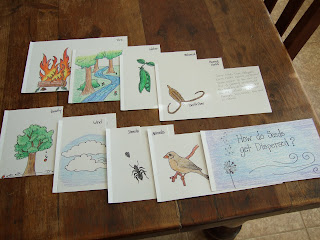


After learning the photosynthesis song, http://www.youtube.com/watch?v=C1_uez5WX1o, we create a photosynthesis model. This model begins as a single sheet of copy paper. Fold it in half and cut out a large leaf shape. Very little scrap should be left over, but don’t toss it away! The two leaves are glued together from the petiole towards the tip. We draw in veins and label the upper epidermis. Fold the upper leaf back, so it stands up and away from the lower leaf. Draw the veins on the lower leaf. I show the students how to draw a cross-section that indicates the epidermis layer. Using some of the scraps, we cut and color a scalloped strip to represent the chloroplasts. This gets glued to the upper leaf, along the inside, right at the fold. Finally, students cut out 4 arrows, free-hand or stenciled, label each with the basic steps of photosynthesis, and glue them to the leaf.














